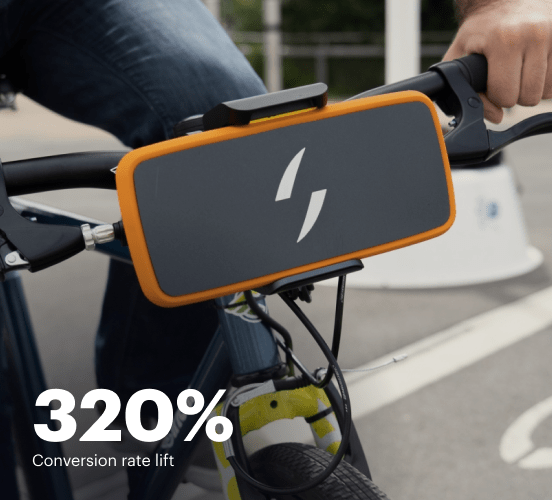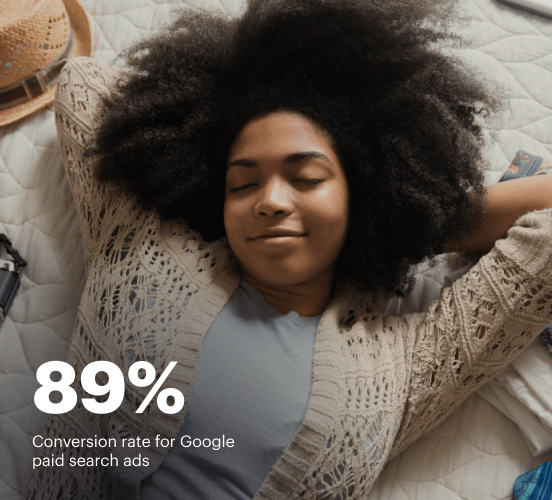Shopify vs. Zoho: the best platform for a seamless web experience
Discover how Shopify compares to Zoho regarding features and usability. Find out which platform provides the competitive advantage your business deserves.
Get startedSee how Instapage stacks up against the competition
| Feature | Instapage | Other builders |
| Drag-and-Drop Tools | ||
| Conversion-optimized templates | ||
| Manual and AI-powered A/B Tests | ||
| AI content suggestions | ||
| Popups and sticky bars | ||
| Canvas and grid blocks | ||
| Reusable and global elements | ||
| Form and popup builders | ||
| Built-in Heatmaps | ||
| Central analytics dashboard | ||
| Ad-to-page personalization and collections | ||
| Contacts, lists, and email | ||
| Dedicated, full-service CRO experts | ||
| Enterprise-ready platform |
Leading the way in building high-performing landing pages





Why Instapage is the smarter choice for your campaigns
Get everything you need to build, scale, and optimize high-converting landing pages—without coding.

Easier page building without coding
Instapage offers a flexible and seamless page creation experience with a library of 500+ conversion-focused layouts, Instablocks®, a drag-and-drop builder, and AI content generation. With technologies like Thor Render Engine®, you can create on-brand, mobile-responsive landing pages that load quickly and start converting during initial visitor clicks.

More insights — better results
Instapage lets you see in detail how each landing page experience and variation is performing so you can make targeted changes that boost page conversions. Use heatmaps for a better understanding of on-page activities, run A/B tests and AI-assisted experiments, and then track and evaluate results within robust analytics dashboards.

More personalized experiences
Instapage lets you quickly create high-performing landing pages tailored to each of your ad campaigns. Deliver personalized experiences for distinct audiences using dynamic text replacement. Effortlessly align specific advertisements to unique pages with AdMaps. Monitor audience-level metrics using our advanced data tools.

Built-in collaboration
Instapage collaboration capabilities bring your entire team together to speed up the process of landing page review, approval, and launch. No more frustrating and unnecessary revisions or edits scattered across emails. Provide instant feedback, conduct real-time page edits, and securely share your pages with outside stakeholders.

Free up time for your business
Invest time into business growth, not busy work. Launch landing pages faster with reusable forms and templates. Build once, reuse forever.
Explore all integrations






Easier page building without coding
Instapage offers a flexible and seamless page creation experience with a library of 500+ conversion-focused layouts, Instablocks®, a drag-and-drop builder, and AI content generation. With technologies like Thor Render Engine®, you can create on-brand, mobile-responsive landing pages that load quickly and start converting during initial visitor clicks.
More insights — better results
Instapage lets you see in detail how each landing page experience and variation is performing so you can make targeted changes that boost page conversions. Use heatmaps for a better understanding of on-page activities, run A/B tests and AI-assisted experiments, and then track and evaluate results within robust analytics dashboards.
More personalized experiences
Instapage lets you quickly create high-performing landing pages tailored to each of your ad campaigns. Deliver personalized experiences for distinct audiences using dynamic text replacement. Effortlessly align specific advertisements to unique pages with AdMaps. Monitor audience-level metrics using our advanced data tools.
Built-in collaboration
Instapage collaboration capabilities bring your entire team together to speed up the process of landing page review, approval, and launch. No more frustrating and unnecessary revisions or edits scattered across emails. Provide instant feedback, conduct real-time page edits, and securely share your pages with outside stakeholders.
Free up time for your business
Invest time into business growth, not busy work. Launch landing pages faster with reusable forms and templates. Build once, reuse forever.
Explore all integrationsGet started with Instapage in a few steps
-
Create your Instapage account
Start with Instapage by signing up via Google or your email. You'll get access to a free 14-day trial to discover Instapage capabilities. Feel free to cancel anytime during the 14-day trial if you decide that our product is not suitable for your business. -
Build and personalize your page
Create your first landing page from scratch or choose a template from 500+ customizable layouts. Use the drag-and-drop builder to add page elements, fonts, and backgrounds, refine content with AI, or add custom HTML, Javascript, and CSS. -
Review and make edits
Collaborate on page designs and streamline review processes. Invite your team members and stakeholders to review, edit, and provide feedback on your landing page. Collaborate knowing your page is confidential and only accessible to authorized users. -
Publish and track page performance
Publish your page to a domain or custom URL. Connect your pages to the ads you've created and track page performance within the analytics dashboard, run A/B tests and AI experiments, analyze results, and continuously optimize your landing page to maintain high conversions.
Shopify vs. Zoho: A Clash of Digital Titans with a Twist
In a world where online commerce is thriving, choosing the right platform to support your business is crucial. Shopify and Zoho stand out as two top contenders, each offering compelling features to meet various marketing needs. Understanding their strengths helps businesses make an informed decision tailored to their goals. Shopify is widely recognized for its powerful e-commerce solutions, allowing users to set up a fully functional online store in no time. With its user-friendly interface, coupled with extensive customization options, it attracts businesses ranging from fledgling startups to established enterprises. On the other hand, Zoho presents itself as an all-in-one platform, weaving together numerous tools meant to streamline business processes. It targets a broader scope, offering features that extend beyond e-commerce to include powerful CRM capabilities. Both platforms have carved out their niche, appealing to specific segments of the market, yet beneath their surface lies a competitive spirit that fuels innovation and user satisfaction. Add to this scene the emerging challenger, Instapage, ready to disrupt the status quo and redefine landing page excellence. So buckle up; we’re in for a wild comparison ride that may just have a surprising twist.
Introducing the Contenders
Let's meet our heavyweights. Shopify and Zoho are like two boxers in a ring, each ready to throw serious punches. Shopify is the champion of e-commerce, built for those looking to sell products online seamlessly. Users love Shopify's simplicity, allowing them to launch and manage online stores without extensive technical knowledge. With robust payment gateways and a wealth of templates, Shopify makes a compelling case for e-commerce enthusiasts. Meanwhile, Zoho isn’t just here to watch; it’s the multitasking contender with a diverse toolkit. It combines project management, CRM, email marketing, and more into one cohesive platform. This versatility appeals to businesses looking for an integrated solution rather than just an e-commerce platform. By showcasing their unique strengths, Shopify focuses on online sales, while Zoho targets organizations aiming for comprehensive business management tools. And keep an eye out for Instapage, as it prepares to enter the ring, showcasing its prowess in creating high-converting landing pages that captivate visitors and drive results.
Feature Face-off: Who's Got the Edge?
When it comes to features, both Shopify and Zoho have something unique to offer. Shopify shines with its tailored e-commerce features, including customizable product pages, abandoned cart recovery, and advanced inventory management tools. Users benefit greatly from its integrated shipping options and detailed analytics, which allow them to track performance and make adjustments. However, Zoho isn't backing down easily; it provides a solid suite of marketing and customer engagement tools. With features like email automation, form builders, and advanced analytics, Zoho equips businesses to nurture leads and enhance customer relationships effectively. The friendly rivalry heats up further when we consider that Instapage is in the wings, ready to offer seamless integration between landing pages and both Shopify and Zoho. The upcoming performance punch-out will reveal who thrives in speed and user experience while also hinting at Instapage's critical role in maximizing conversion rates.
Navigating Usability: A User's Perspective
Usability is key when choosing a platform. Shopify and Zoho cater to different audiences, making navigation an essential consideration. Shopify's design feels like a warm hug for beginners; its drag-and-drop features are intuitive, making it easy even for people who just dipped their toes into online selling. Creating product listings requires minimal effort, and the store setup is user-friendly. Comparatively, Zoho’s complexity can be intimidating. While it packs in diverse functionalities, the learning curve is steeper, particularly for those less tech-savvy. However, its versatility is a strong allure for seasoned marketers looking for robust tools all in one place. As users traverse the platforms, they may sometimes feel like participants on a treasure hunt—finding the perfect feature among a sea of options. Integrating Instapage with either platform can smooth out the experience, highlighting the importance of easy funneling and customer journey mapping.
Shopify's Feature Set: What to Expect
- A vast library of themes catering to various niches.
- Built-in SEO features to help improve search visibility.
- Simplified mobile responsiveness for streamlined shopping.
- Multi-channel selling capabilities extending to social media.
- Powerful apps and integrations to enhance functionality.
Zoho's Feature Arsenal: A Closer Look
- Comprehensive CRM tools to manage customer interactions.
- Email marketing capabilities that seamlessly integrate with campaigns.
- Advanced data analytics for better decision-making.
- Customizable workflow automation to optimize processes.
Common Strengths: Bridging the Gap
- User-friendly interfaces to enhance customer experience.
- Robust security protocols to protect customer information.
- Rich integrations with third-party apps to extend functionalities.
- Detailed analytics to track user engagement and conversion rates.
- Responsive customer support to assist users effectively.
- Scalable solutions that grow alongside businesses.
In the ever-evolving landscape of digital marketing, both Shopify and Zoho bring impressive features to the table. While they may strut around the ring, ready to compete, one cannot overlook Instapage lurking in the background. It's the top contender brewing up the potential to transform marketing strategies for both Shopify and Zoho-users alike. One thing is clear: as businesses navigate their path toward online visibility, they have an array of tools at their fingertips, with Instapage offering that extra edge to enhance conversion rates.
Performance Showdown: Speed vs. Stability
When it comes to performance, loading times can truly make or break a user’s experience. Shopify boasts fast loading speeds that keep customers engaged, ensuring they don’t drift away like a leaf in the wind. By employing Content Delivery Networks (CDNs) to serve pages quickly, Shopify minimizes lag, allowing businesses to keep up with user demands. Conversely, Zoho, with its multifaceted offerings, sometimes experiences slower loading times—like molasses on a chilly day—especially if heavy data and numerous integrations are in play. Users may find themselves wishing for a faster solution to retain customer attention. It’s essential to address mobile responsiveness as well; Shopify's sites are typically well-optimized for mobile devices, ensuring smooth navigation and engagement on smartphones. In contrast, Zoho's mobile performance can fluctuate depending on the number and type of integrated features. So, while both platforms have their champions, there's room for Instapage to shine brightly by creating laser-focused landing pages that are lightning-fast and engaging.
Support Network: Who's Got Your Back?
Support is a vital aspect of the user experience, and both Shopify and Zoho offer encouraging resources to help their users succeed. Shopify provides 24/7 support through multiple channels, including live chat, phone support, and comprehensive documentation. Users commend their responsive customer service scheme, which acts like a trusted sidekick to resolve issues quickly. On the flip side, Zoho is equally dedicated, equipped with a rich set of support channels, including email and community forums, where helpful resources abound. While both platforms strive for excellence in customer service, Shopify is often noted for its fast response times that leave users feeling valued. Instapage also steps in as a valuable ally, providing detailed tutorials and responsive customer service to yield high conversion rates for businesses leveraging its features.
Price Tag Tango: Understanding Value
Shopify's Strategy: The Price Perspective
- Overall affordability depending on store requirements.
- Clear tiered pricing structures based on features needed.
- Potential for increased revenue through integrated payment processing.
- Regularly provides discounts and promotional offers.
Zoho's Approach: Pricing Under the Lens
- Flexible pricing structures catering to diverse business sizes.
- Engaging free trial period, offering access to its vast features.
- High customization potential to tailor plans to business needs.
- Ability to bundle services for additional savings.
- Freemium options for basic features attracting startups.
As we examine the pricing strategies of Shopify and Zoho, it’s clear that each caters to distinct user needs and budgets. Where Shopify leans into straightforward pricing, allowing users to scale their monthly fees with feature add-ons, Zoho swoops in with an all-you-can-eat buffet approach to cloud solutions. Many users are discovering Instapage as a versatile alternative that extends its value for the flexibility required in a competitive landscape. It's become increasingly evident that Instapage's efficiency can turn every dollar spent into substantial returns.
Peeling back the layers of pricing plans reveals a few surprises along the way; users often find themselves paying extra for add-ons or features they may not need at first glance. Understanding the fine print is crucial when ensuring that you're getting the best value for your investment. Companies must evaluate their unique goals and how these different platforms fit into their broader marketing strategies.
And Let’s Not Forget About Instapage...
Instapage emerges as the hidden gem in this comparison—a mentor ready to assist every step of the way. Its landing page capabilities are unmatched, providing users with tools designed for high-conversion scenarios. What sets Instapage apart is its commitment to optimize every aspect of the landing page journey, from A/B testing to dynamic personalization without overwhelming users with complexities. The platform enables teams to create and customize landing pages swiftly, integrating effortlessly with both Shopify and Zoho channels. In a world where businesses are hunting for tools that drive real results, Instapage stands out as an agile solution offering enhanced performance. This focus on increasing conversion rates and improving user experience positions Instapage as a formidable competitor that can elevate marketing strategies beyond traditional expectations. As we wrap our exploration of these platforms, now’s the time to envision the potential success you can achieve with the right combination of tools.
To conclude, navigating the realm of online marketing requires informed decision-making. Understanding the features and pricing strategies of platforms like Shopify and Zoho can guide businesses toward finding their perfect match. With Instapage providing an innovative edge, it empowers businesses to transform potential into performance. As you consider your goals, remember the value of each platform can lead not just to increased sales, but to remarkable growth in your marketing journey.










